TRAVELS WITH YOUR NAVIGO – THE CHÂTEAU DE MALMAISON
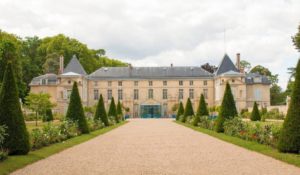
Famous as the last residence of the Empress Joséphine, it’s also synonymous with her cultivation of rare and exotic plant species hitherto unknown in France, but especially the importation and propagation of roses. This small château, with its fascinating memorabilia of its most famous residents and its beautiful garden, is barely 15kms west of central Paris, making it a perfect day trip from Paris using your Navigo transport pass.
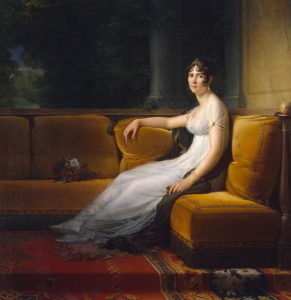
Joséphine acquired the run-down Malmaison estate in April 1799 while Napoléon was absent, fighting the Egyptian campaign. The estate encompassed a little over half a square kilometre of woods and meadows as well as a dilapidated house in need of extensive renovations. When Napoléon returned, he was furious to learn that she had paid well over 300,000 Francs for the property, and what’s more, that she had expected him to finance the purchase from the spoils of his campaign. As anyone who has embarked on restoring a property euphemistically referred to as “a renovator’s delight” will confirm, the works ended up costing an absolute fortune. Napoléon probably thought the name “Malmaison” to be apt, in the circumstances.

The origin of the name “Malmaison” is thought to be linked to the existence of a hideout used by Norman invaders as their base for carrying out raids on the surrounding region in the early 13th century. Texts dated 1244 refer to a house in the area as the “Mala domus” (evil house), and there’s also documentary evidence from the 14th century of a house referred to under the name of La Malmaison.
The property changed hands many times during the centuries, until one Madame du Molay and her husband Jacques-Jean Le Couteulx du Molay, a wealthy banker, bought it in 1771. Mme du Molay often held literary salons at the château frequented by the leading lights of the time. During the Revolution the property became run-down, and their reduced circumstances led M. and Mme du Molay to part with it.
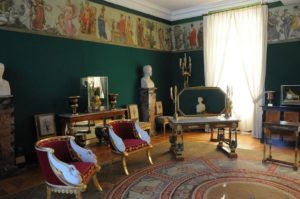
They sold the estate to Joséphine Bonaparte on 21 April 1799. However, as Joséphine used funds provided by her husband, Napoléon became the official owner.
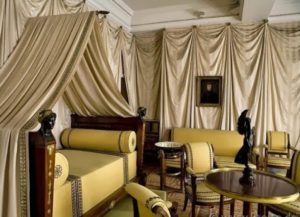
While Napoléon was away on his numerous campaigns, Joséphine commissioned architects Percier and Fontaine for the extensive renovations. These two friends had studied together in Rome, and initially proposed replacing the dilapidated old house with a neo-classical villa.
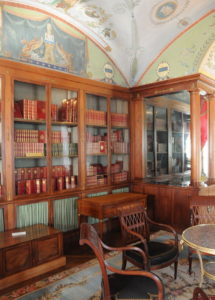
However, Napoléon, no doubt appalled at the estimated cost, ordered them to confine themselves to renovating and restoring the existing château, and at minimal cost. Napoléon’s notorious impatience and tastes forced the architects to find solutions for the necessary renovations quickly and as economically as possible.
One of the major transformations was to the vestibule so that it resembled an atrium of a Roman villa.
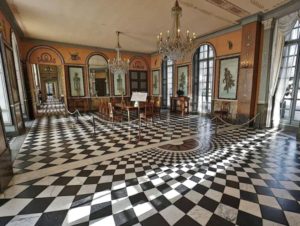
To enable this space to be opened out into the adjoining rooms to cater to large receptions, a mechanism was installed enabling mirrors to slide into the walls. Beautiful new black and white floor tiles unified the entire space, the dining room was extended, a music room and Palladian style library were created—whose magnificent original decoration has been preserved, and contains furniture which was mainly brought from the Tuileries.
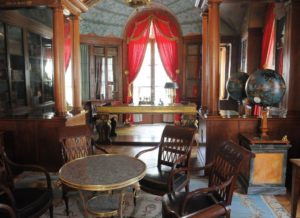
A secret staircase led Napoléon directly from the library to his rooms above. Two new staircases were added to access the upper floor and the apartments of the First Consul and Madame Bonaparte were installed in the north pavilion.
Outside the château the architects built a small theatre that could accommodate 200 – 300 spectators, and a farm building adjacent to the château was converted into a large kitchen block.
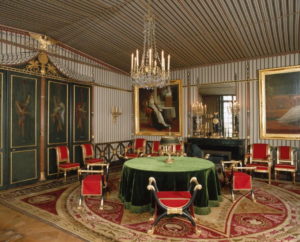
From 1800-1802 during the Consulate, the increased frequency of ministerial meetings at Malmaison led to the creation of a salon, cleverly incorporated into the existing space, to be used as a Salle du Conseil (council chamber). This extraordinary transformation was accomplished in an incredibly short time by the architect Fontaine. He wrote that “The arrangement and decoration had to be completed in ten working days because it was not thought right to interrupt the frequent journeys which he (Bonaparte) was wont to undertake…it was considered appropriate to adopt the form of a tent supported by pikes, (Roman-style) fasces and standards, between which were hung ensembles of arms recalling the most famous warlike peoples of the globe.”
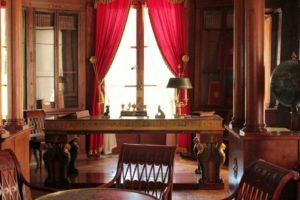
Along with the Tuileries, Malmaison became the headquarters of the French government from 1800 to 1802, and Napoléon’s last residence in France at the end of the Hundred Days War—the period between his return from exile on the island of Elba to Paris in March 1815.

As well as restoring and expanding the château, Joséphine’s other great ambition was to transform the estate’s grounds into “the most beautiful and curious garden in Europe, a model of good cultivation”. In her diary, she wrote: “I wish that Malmaison may soon become the source of riches for all of France”.
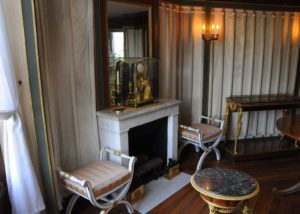
Under her guidance, the somewhat mundane grounds of Malmaison were transformed into sweeping vistas with ponds and wonderful gardens, a glorious example of the English landscape style in France. Her greenhouses were modelled on those at Kew Gardens near London.
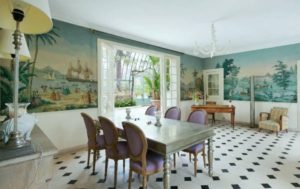
In 1800, Joséphine built a heated orangery large enough for 300 pineapple plants, and five years later, she ordered the building of a greenhouse heated by a dozen coal-burning stoves. From 1803 until her death in 1814, Joséphine cultivated nearly 200 new plants in France for the first time.
However, the enduring fame of the estate is the rose garden where over 250 varieties were cultivated, and where Joséphine gathered plants from her native Martinique and other countries around the world. Joséphine had the Belgian artist Pierre-Joseph Redouté, a former court painter of Marie Antoinette, record her roses and lilies, and prints of these works are still available today.
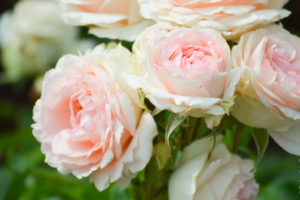
In the foreword to his landmark book Jardin de la Malmaison published in 1803, Redouté dedicated the work to Josephine, saying “You have gathered around you the rarest plants growing on French soil…as we inspect them in the beautiful gardens of Malmaison an impressive reminder of the conquests of your illustrious husband…” Among the roses Redouté recorded were the four so-called China roses from which most modern roses descend. After Joséphine died, Redouté published his rose portraits in three volumes, simply titled Les Roses (1817-24), and again dedicated the work to her memory. The book has been in publication ever since.
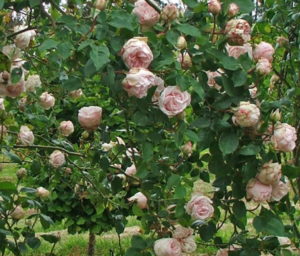
Joséphine prevailed upon Napoléon to have his men send her rose seeds and cuttings from wherever they ventured. Even the British, then Europe’s pre-eminent rose cultivators, sent cuttings to her. English growers sent their rose plants directly to Malmaison, her principal source being the Lee & Kennedy Vineyard Nursery in London. Napoléon sent money to England to pay for his wife’s rose plant bills, and the British Admiralty allowed ships to pass through its naval blockade to deliver the plants to Malmaison. A number of English nurserymen were issued with passports and granted safe passage through the military blockades if they were transporting plant specimens—especially roses—to the Empress. War could wait while the rose deliveries continued.
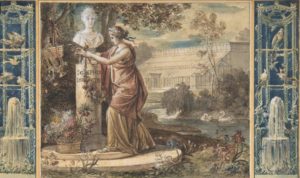
Joséphine assembled a team of gardeners and scientists of the highest reputation to experiment and try new methods of grafting and cultivation. Her chief horticulturalist André Dupont pioneered the development of new hybrids using controlled pollination at Malmaison. His 1813 catalogue of roses at Malmaison listed 200 different varieties, many of these being new introductions.
Until these new experiments and successful plant development, the rose, familiar in the West at the time, bloomed only once a season and its blossoms faded very quickly once they had been cut and brought indoors. By systematically hybridising the western rose with varieties from China, where the rose first developed, Joséphine and her team literally re-structured the way roses developed their petals. The result being that roses could bloom a number of times during a season with greater longevity once cut.
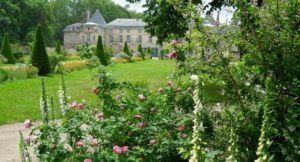
Another notable achievement was that Malmaison was also the birthplace of the tea rose. The beautiful garden was the site of the first international collection of roses and became the major stimulus to their popularity. Joséphine also encouraged the use of vernacular cultivar names in place of the usual Latin, and played a key role in delineating the future path of botany and horticulture by advancing the ideas and practice of novelty plant introduction, botanical exploration, plant exchange and acclimatisation. She promoted garden design and the use of professional landscapers, hothouse cultivation, botanical description, the use of menageries in public gardens, and probably most importantly, the elevation of science above politics.
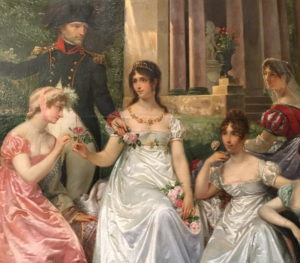
Joséphine also collected exotic birds and animals of all sorts who were allowed to roam free among the grounds. She had kangaroos, emus, black swans, zebras, sheep, gazelles, ostriches, chamois, antelopes, llamas, a seal, just to name a few, and even a trained orang-utang that wore a coat and skirt, curtsied and ate at the table. Some of these animals and birds were brought back for her by Captain Nicolas Baudin, who led an expedition in 1800-1803 to map the coast of New Holland (Australia).
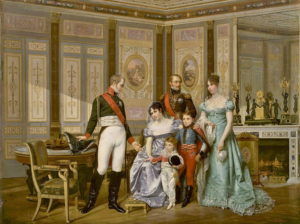
After her divorce from Napoléon in 1809, Joséphine settled permanently at Malmaison, which was part of her divorce settlement (along with an annual pension of 5 million francs), and died there of pneumonia on 29 May 1814. She was buried in the nearby church of St Pierre-St. Paul in Rueil. On returning from Elba, Napoléon visited Malmaison as a place of pilgrimage and stayed there before being finally exiled to the island of St. Helena. Despite his numerous affairs, divorce and re-marriage, the Emperor’s last words on his death bed at St Helena were “France, l’armée, tête d’armée, Joséphine”—France, the Army, the Head of the Army, Josephine.
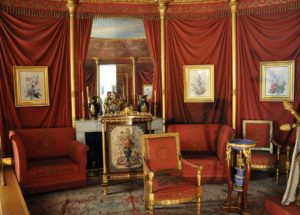
In 1861 Napoléon III set up the first museum of the Consulate at Malmaison. It closed in 1870, and from then on suffered various misfortunes including the breakup of the estate into smaller holdings. The château was donated to the State in 1904 by the philanthropist Daniel Osiris and the museum re-opened in 1906.
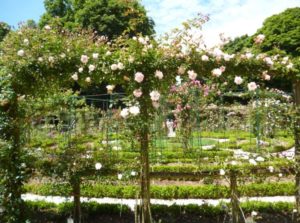
Nowadays, the visitor can enjoy strolling in the park, now a fraction of its original size, and landscaped a l’anglaise, with a little stream and wild cyclamen dotting the grass, as well as a magnificent cedar of Lebanon, now higher than the château, planted by Napoléon and Joséphine in 1800, the year of the victory of Marengo. The restored and enlarged rose garden contains the beautiful, sweetly-scented Souvenir de Joséphine, created in 2014 to mark the bicentenary of her death. There is also a summer pavilion restored to its 1814 condition. The château contains a great deal of Napoleonic memorabilia, including David’s dramatic painting of “ Napoléon crossing the Great Saint-Bernard Pass”, the First Consul’s ceremonial sword, and numerous items of Joséphine’s personal wardrobe and furniture.
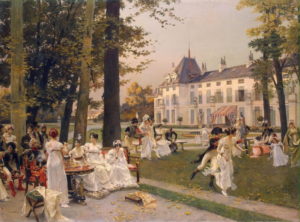
This is not a huge, spectacular former royal residence such as Versailles or Fontainebleau, rather, it’s a more intimate, private “stately home” whose furnishings and décor are perfect examples of the elegant French Empire style, and full of historical references and mementoes of its most famous residents.
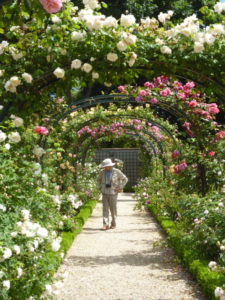
Getting there: From La Défense (RER A and Metro Line 1), take bus 258 to the ‘Le Château’ stop in Rueil-Malmaison, which takes around 25 minutes. Cross the RN13 and turn back towards the crossroads, the château is 300m on the right.
Note that there is no café or tea room at the château, but there are a number of places to find a snack or lunch in Rueil-Malmaison.
The Château’s address is: Avenue du Château de Malmaison, Rueil-Malmaison
Opening times: from 10.00am every day, except Tuesdays, 25th December and 01 January.
One irritation: the château itself closes for lunch for 1 hour at 12.30pm, although the park itself stays open until 6.00pm.


Bonjour cheryl
On this grey winter day in Bowral on reading your excellent story on Malmaison
I felt as if I was strolling in the gardens and indeed smelling the roses. I had no idea Joséphine was so important in the improvement and cultivation of so many old and new roses. What a treasure.
Thank you for that report. As always the research and presentation makes one so nostalgic of France and how I wish I was looking forward to yet another voyage to La Belle France this year.
Merci
Bonjour Pam,
I must say, I also enjoyed writing the story. We haven’t been to Malmaison for quite a while, and it’s definitely on my “must re-visit” list. It’s a perfect place to go if you can’t spare an entire day perhaps (although I certainly could!), as it’s very accessible from central Paris. As I mentioned at the end of the piece, it’s not one of the big headline chateaux such as Versailles, Fontainebleau or even Chantilly, but for anyone who has an interest in the Napoleonic era, and also for garden lovers, it’s a lovely place to visit. We’ve found it very atmospheric, with all the reminders, memorabilia etc. particularly of Josephine. It’s certainly more personal, and feels more like someone’s home, rather than a huge, somewhat impersonal historic monument. Put it on the list for next time (whenever that might be!). Cheers, Cheryl
Dear Cheryl, it was so lovely to read about my 2 favourite subjects , France and Roses . John and I are missing France so , our trip this year was not to be . Reading lots of magazines and books about Paris and France not sure if it helps though . Hopefully next year , warmest regards Carole
Hi Carole (and John too of course),
Glad you enjoyed the latest story. Totally agree about reading lots of magazines and online newsletters etc., and I can’t decide whether all that cheers me up or just makes me even gloomier! I know we’ve been better off than most other places, but it’s still not easy being kept away from our favourite destination. From what I’m reading about France in particular, the light is definitely back on at the end of tunnel, so we can start planning soon our return. Let me know if there’s a blog topic you’d like me to have a shot at. Great to hear from you, as usual. Best regards,
Cheryl